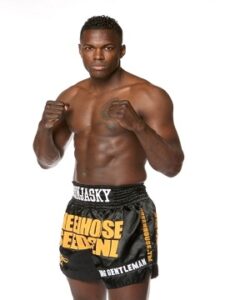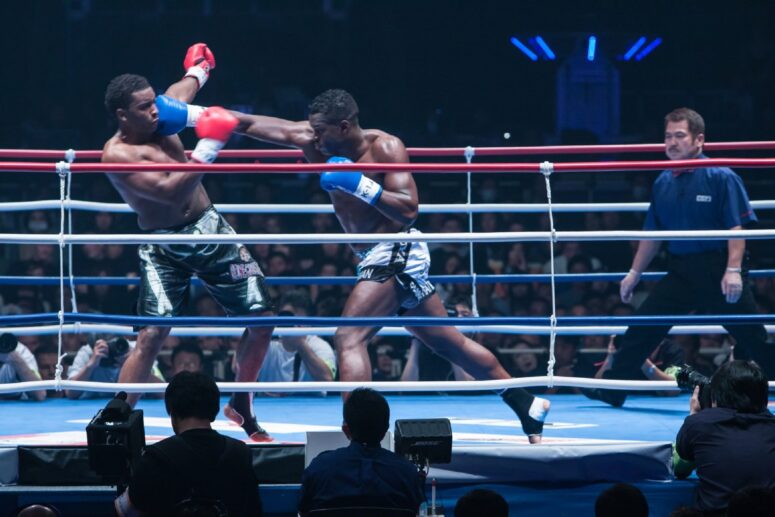The legendary 3x K-1 Grand Prix winner.
As is the norm with most boxing or kickboxing legends, Remy Bonjasky comes from humble beginnings. Born on 10 January 1976 in Suriname, South America, he and his family moved to The Netherlands in seek of a better life. Bonjasky was aged only five at the time but saw this as an exciting adventure. Indeed, events in The Netherlands would set him on an adventure that would ultimately lead to the K-1 world championship.
A keen footballer as a child and teenager, it wasn’t until Bonjasky was 18 that he turned to Muay Thai – he and his friends had been inspired by the Jean Claude Van Damme movie Bloodsport. They joined the local Mejiro Gym in Amsterdam and it would be here and under the guidance of trainer Andre Manaart, that Bonjasky would develop as a fighter and win his first two world championships.
After only a year of training and at the age of 19, Remy had his first professional Muay Thai contest. It was against future MMA star Valentijn Overeem and ended with a round two TKO victory for Bonjasky. His great debut was followed by a respectable nine victories from his first 12 fights.
This led to an opportunity in 2001 to fight at the prestigious K-1 Grand Prix event in Holland. Unfortunately for Bonjasky, his opponent would be Jerrel Venetiaan – a fighter he had lost to the previous year. Venetiaan again proved to be too much for Bonjasky, and won on points for the second time.
Despite his K-1 career getting off to the worst possible start, things were about to take a turn for the better. Established star Ray Sefo would be Remy’s second opponent. This would be a daunting task for any K-1 fighter, but all the more so considering the significant difference in experience between the two. Bonjasky showed glimpses of what was to come as he stopped Sefo with a TKO in the fourth round.
Over the next few years he continued to show good form with victories over stars such as Melvin Manhoef and Bjorn Bregy. Interestingly, Remy would only fight and train on a part time basis as he was working as a network operator for a large Internet company. This would continue until the age of 25, when he decided that if he was to ever realise his dream of becoming world champion, he would have to leave his job and train full time.
It wasn’t until 2003 that Bonjasky had his first real success and showed the great talent he possessed. This first happened in America, when he won the Las Vegas Grand Prix, defeating accomplished Canadian fighter Michael McDonald in the final.
Later that year he cemented his place among the big names by winning the first of his World Grand Prix Finals. Peter Graham and Cyril Abidi were both KO’d in the quarter and semi-finals respectively, before he met Japan’s favourite son, Musashi, in the final. Despite Musashi enjoying home support from the partisan crowd, Bonjasky used his superior skills to clearly beat his opponent over the distance to win by a unanimous decision. After only training full-time for a year and a half, Bonjasky had amazingly won his first world championship.
The following year would again wield triumph for Remy. He successfully defended his K-1 crown to become a double World GP winner. However, it would prove to be far more difficult than his first championship. Under K-1 rules, if a bout is scored as a draw after the regulated three rounds, the fight will go to a fourth (or maybe even a fifth round) until a winner can be decided. For Remy, each of his three fights in the GP Finals would go to that extra fourth round. His opponent in the quarterfinal would be none other than four times world champion, Ernesto Hoost. A very difficult challenge, but Remy showed his worth by beating a living legend. The semi-finals would see Remy paired with former heavyweight boxing champion, Francois Botha. He again ground out a point’s victory to meet Musashi, for the second time, in the final. On this occasion Musashi proved a far more challenging opponent, but after four very close rounds, Bonjasky was again proclaimed as the champion. His tally of 12 rounds over the three bouts remains a record for any fighter on his way to winning the title.
Train Hard, Fight Easy!
Over the next few years, Dutch giant Semmy Schilt would win the Grand Prix title three years in a row and end Bonjasky’s reign as champion. During this time, Bonjasky experienced a mixture of highs and lows. In 2006 after a long and drawn-out process, he finally divorced from his wife. Something that he admits affected his form for much of 2005. He also parted company with long-term trainer Andre Manaart that same year. It was not an easy thing to do considering that they had worked together since he was a teenager, but Remy felt that Muay Thai alone at the Mejiro Gym was no longer enough. He moved to the Vos Gym and to the tutelage of Ivan Hippolyte. Here Remy would receive a more all-round training regime with Eric Warmerdam also being brought onboard to help develop greater boxing skills. Full conditioning work, nutritional advice and weight control were given here – aspects that were not focused on as much at his previous gym. A further positive came in 2007 – after helping the police to apprehend criminals who were firing darts at pedestrians from a van; he was awarded a medal for bravery.
- K-1 World Grand Prix winner 3x
- IPMTF European Super Heavyweight Championship
- KO Power Tournament Runner-up

Going into the 2008 World GP Finals, Remy weighed a full stone heavier than at any other time in his career. His trainers believing that extra bulk was required to go with his lightening quick ring speed. Jerome LeBanner, Bonjasky’s opponent in the quarterfinals, had to withdraw in the second round owing to an old arm injury that had resurfaced. A relatively easy passage to the semi finals saw Turkish fighter Gorkan Saki as the next obstacle to be overcome. He was dispatched with by one of Bonjasky’s legendary flying kicks in the second round, being unable to beat the count.
Bonjasky would then contest his third final with ‘Bad Boy’ Badr Hari as his opponent. It is with good reason that Hari has this nickname, as the world would soon see. Badr, after being knocked down in the first round and aware that he was behind on points, came out for the second like a man possessed. Midway through the round he pushed Bonjasky to the ground, and as Remy lay on the canvas, Badr followed up with a couple of blows to the head. The referee tried to intervene but before he could push him away, Badr proceeded to stomp on Remy’s head. The crowd looked on in sheer disbelief. Initially Badr was just given a one-point penalty by the referee, but this was later increased to full disqualification when the ringside doctor reported that Bonjasky was in no fit state to continue. Bonjasky was declared the winner and claimed his third world title. With tears in his eyes, he announced to the crowd “I wanted to win, but not this way”, after the most controversial final in K-1 history.
It was not the first time that Remy Bonjasky had been involved in a controversial bout – he was also punched while grounded in a 2003 fight with Bob Sapp. Sapp received a disqualification for his efforts. In a 2006 fight against Jerome Lebanner in Amsterdam, the three Dutch judges awarded the verdict to Remy. It was a clear case of favouring the home fighter. LeBanner appealed against the result to the K-1 organisations of Japan and America, who overturned the result and awarded victory to the Frenchman. Unsurprisingly for people that know Remy, he was not to blame for any of the controversial situations he has found himself in.
Remy was always good for the sport of K-1. He was arguably the most technical fighter in the Heavyweight Division – his flying kicks and knee strikes were truly spectacular. Outside of the ring he was always well spoken and displayed charm in front of the camera – it is no wonder that he picked up the nickname ‘The Flying Gentleman’. Finally, It was also great to see Remy’s achievements being recognised outside of the K-1 community, as he was awarded the status of Honorary Citizen in the Dutch city of Almere in early 2009. Champion, gentleman, and a true legend!


